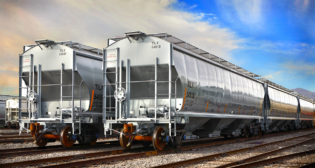
Fracking: The view from 50,000 feet (up)
Written by William C. Vantuono, Editor-in-ChiefThis certainly includes the provision of leased sand cars to bring sand into the wells at which fracking plays a role in extracting oil and/or gas. The railroads are probably also shipping pipe and machinery to these sites.
It also includes the thousands of tank cars that are being built and leased by a variety of parties to end-users that need to move the extracted oil and gas to wherever it wants to go.
I thought I would give you some “50,000-foot” views on just why rail is such an important component to the fracking story:
• I have been told by more than one source that one of the profound impressions they have taken away from discussions with end-users of tank cars for CBR (crude by rail) and LNG (liquefied natural gas) is that the costs of buying or renting the cars to transport these products seem minor compared with the amount of profit that can be made in moving the products themselves: Some have gotten the impression that companies needing these cars will pay anything to get them. I haven’t been privy to similar discussions regarding rail shipping rates, but it would seem that the same rule may apply. By the way, kudos to our Class I, II, and III railroads for their role in developing this new business!
• Experience with CBR is teaching shippers that the old rules for moving oil by pipeline (the oil goes where the pipeline goes) don’t apply to CBR. If a better price can be had at a refinery on the East Coast than the Gulf Coast, rail can deliver that extra profit. The advent of 100-car unit trains of CBR just makes things more efficient.
· The efficient transit times that our rail system has achieved for various kinds of freight are adding to the attractiveness of CBR. In fact, one of the main reasons that the fracking industry has been as successful as it has been (other than extracting the oil and gas) is the existence of a rail system that can pick up loads almost anywhere and deliver them almost anywhere. If you read reports of fracking opportunities in Europe (where the rail system is largely configured for passenger trains) or Africa (where there are few good railroads), read them with the knowledge that the fracking will most likely have to be accompanied by an expensive pipeline.
In the 30 or so years I have been involved with rail equipment finance, there have been other periods of relative euphoria in our industry. However, these earlier periods of “good times” were almost always followed by a significant market drop lasting for years, during which excess railcar building was digested. For instance, there were boxcar and grain cars overbuilds in the late 1970s that polluted the market until the late 1980s. Often, these periods of adjustment resulted in some significant distress for the players involved.
Even with this historical perspective as a warning flag, I have been hard pressed to see any near term discernible downside to the railcar building that has been going on to service the hydrocarbon industry. The estimates of available to-be-fracked oil reserves continue to rise. So do the new tank car orders that are tied to them.
Will there be a market crash? It’s not easy to predict, but if this bulge of CBR and LNG railcars are briskly amortized by the profits they have the capacity to earn, no one—neither lessor nor lessee—should get hurt.



